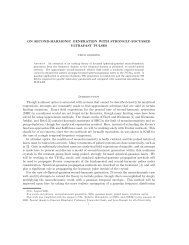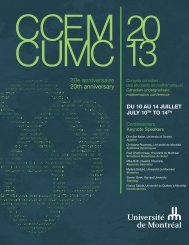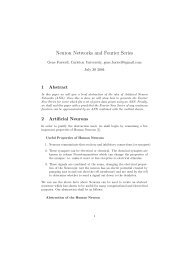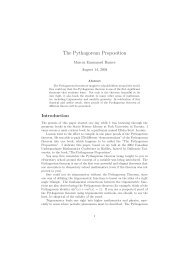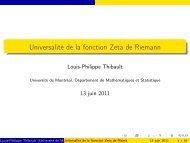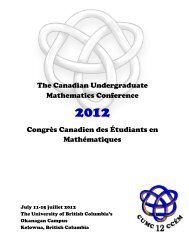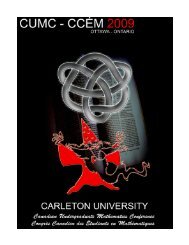booklet - CUMC - Canadian Mathematical Society
booklet - CUMC - Canadian Mathematical Society
booklet - CUMC - Canadian Mathematical Society
You also want an ePaper? Increase the reach of your titles
YUMPU automatically turns print PDFs into web optimized ePapers that Google loves.
WHY STUDY MATH?IRENA PAPSTLast year, I wrote a thesis based on a (seemingly) simple question: "Why studymath?" More specifically, I was interested in why students decided to pursue math asundergraduates, and what it was that they were getting out of their degree. I choseto conduct in-depth interviews with McMaster undergraduates in the Department ofMath and Stats. The ultimate goal of my study was not to answer the above questionsdefinitively, but rather to contribute to the dialogue related to the undergraduate experiencein the McMaster Math and Stats department. What is that we are doing well?What could we be doing better? In my talk, I will present a summary of my findings,especially as related to a concept called "mathematical maturity". However, the focalpoint of this seminar will be the extended discussion period following my presentation.I would like to hear your reactions to these findings, particularly as they relate to yourundergraduate experience. Anglophones and francophones are both welcome!SUSLIN’S COUNTEREXAMPLEJACOB FUNKIn 1905, Henri Lebesgue introduced a lemma about projetions of Borel sets in R n inorder to prove a result concerning invertible Baire funtions. For every Borel set in R n ,its projections on to R i are also Borel sets. The proof in his paper was straightforward,following as many proofs in measure theory do. Since the projections of open sets areopen, one must only show that this projective property holds under countable unionsand intersections. Unfortunately, Lebesgue’s proof was incorrect, and surprisingly, theresult isn’t even true. In my talk I will discuss the incorrect proof provided by Lebesgueand the theory developed by Suslin when he studied this error. Finally, I will showexplicitly the construction of a two-dimensional borel set with a non-borel projectionon to the real line.Required Background: Familiarity with the Borel sets.HOW TIGERS GET THEIR STRIPESJANA ANDERSEN-AITKENThe Turing model for morphogenesis offers a mathematical explanation for howpatterns form in animal coats. The model describes two chemicals reacting with eachother while diffusing across a domain. The system starts in a stable, homogeneoussteady state which becomes unstable when diffusion occurs. Statistical deviations fromthe homogeneous steady state knock the system out of the homogeneous steady stateinto another steady state which is a pattern. This talk explores the linear analysis ofhow different two diffusion coefficients need to be for perturbations to cause a systemto form a pattern.Required Background: ODEs29



